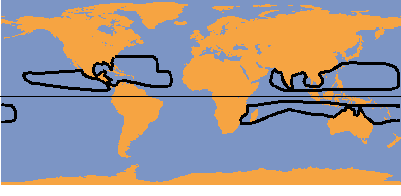|
Hurricanes initiate from an area of thunderstorms. These thunderstorms are most commonly formed in one of three different ways. The first is the InterTropical Convergence Zone (ITCZ). The ITCZ is a near-solid ring of thunderstorms surrounding the globe found in the tropics. In the diagram below, the easterly trade winds converge near the equator and create thunderstorms, which can be seen in the satellite image along the equator.

| 
|
| Image by: GOES Server |
The second source for thunderstorms that can create hurricanes are from eastward moving atmospheric waves, called easterly waves. Easterly waves are similar to waves in the mid-latitudes, except they are in the easterly trade-flow. Convergence associated with these waves creates thunderstorms that can ultimately reach hurricane strength.
| [Image: (24K)] | The third mechanism is along old frontal boundaries that drift into the Gulf of Mexico or coastal Florida. The lift associated with these fronts can be enough to initiate storms, and if the atmospheric and oceanic conditions are sufficient, tropical cyclones can develop that way as well. |
The map below shows the regions throughout the world where tropical cyclones originate. Tropical cyclones are more commonly found in the northern hemisphere, but the Pacific and Indian Oceans both produce hurricanes in the southern hemisphere. However, in other parts of the world, hurricanes are called by different names.

At the equator, ocean surface temperatures are warm enough to produce hurricanes, but none form. This is because there is not enough coriolis force to create spin and induce a potential hurricane.

definition |
|

CISK |